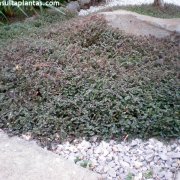Care of the indoor plant Callisia repens or Creeping inchplant |
|
The genus Callisia, family Commelinaceae, includes 20 species of native herbaceous plants, mostly from Mexico and Central America. Some species are: Callisia repens, Callisia elegans, Callisia fragrans, Callisia gentlei. Common names: Creeping inchplant, Turtle vine, Bolivian Jew. This species is native to Central and South America. They are small perennial plants with a hanging or covering habit and brittle stems that reach 30 cm (11.8") in height. The decorative fleshy leaves are heart-shaped and hug the stems. The flowers are small and white but they are not decorative. They bloom in summer. Creeping inchplant is used as indoor plants in hanging pots and as covers in regions with a subtropical and tropical climate. Callisia repens prefers semi-shade exposure as direct sun (especially in Mediterranean climates) can burn the leaves. The winter temperature should not be lower than 15 ºC (59 ºF). The soil can be a mixture, in equal parts, of garden substrate with siliceous sand, peat and leaf mulch or a substrate for indoor plants. Water with lime-free water waiting for the soil to dry. Spray the plant every day with lime-free water in summer. The rest of the year spray 2 times a week. Fertilize with mineral fertilizer every 15 days in spring and summer but in a dose that is 1/3 of the usual. Bolivian Jew does not need pruning but can be trimmed to obtain cuttings. If the humidity is low, Callisia repens can be attacked by mites. Turtle vine propagates by cuttings that root very well in water in any season of the year. |
Images of the indoor plant Callisia repens or Creeping inchplant |
Find plants
Callisia repens or Creeping inchplant | Care and Growing
© 2026 FavThemes




